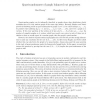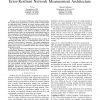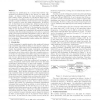526 search results - page 56 / 106 » Increments of Random Partitions |
CORR
2010
Springer
13 years 10 months ago
2010
Springer
Quasi-random graphs can be informally described as graphs whose edge distribution closely resembles that of a truly random graph of the same edge density. Recently, Shapira and Yu...
TCAD
2002
13 years 9 months ago
2002
The design of programmable logic architectures and supporting computer-aided design tools fundamentally requires both a good understanding of the combinatorial nature of netlist gr...
INFOCOM
2009
IEEE
14 years 4 months ago
2009
IEEE
—A novel counter architecture, called Counter Braids, has recently been proposed for accurate per-flow measurement on high-speed links. Inspired by sparse random graph codes, Co...
ICCAD
2005
IEEE
14 years 6 months ago
2005
IEEE
Clustering (or partitioning) is a crucial step between logic synthesis and physical design in the layout of a large scale design. A design verified at the logic synthesis level m...
CVPR
2010
IEEE
14 years 5 months ago
2010
IEEE
Graph-cuts optimization is prevalent in vision and graphics problems. It is thus of great practical importance to parallelize the graph-cuts optimization using today’s ubiquitou...



